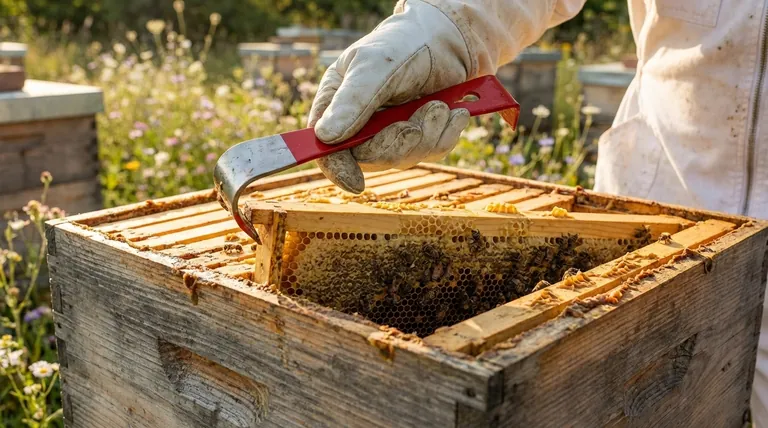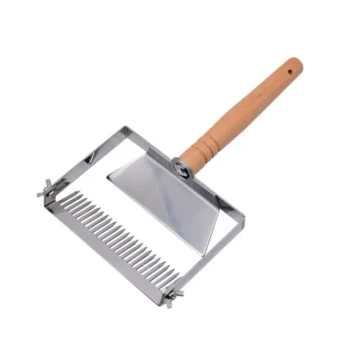A hive tool is the single most essential piece of equipment for any beekeeper conducting an inspection. Its primary functions are to pry apart hive components sealed with propolis, lift out frames for examination, and scrape away excess wax and propolis to maintain the hive. It is the beekeeper's multi-tool, enabling safe and effective interaction with the colony.
A beehive is not a set of loose boxes; it's a fortress glued together by the bees' own resin, called propolis. The hive tool is not just for prying—it's the key that allows a beekeeper to respectfully enter, inspect, and maintain this sealed environment with minimal disruption.

The Hive Tool's Primary Functions
A hive inspection is impossible without a hive tool. Bees use propolis, a sticky, resinous "bee glue," to seal every crack and seam in their home, securing it against weather and intruders. This makes the hive components incredibly difficult to separate by hand.
Overcoming the Propolis Seal
The most common use of the hive tool is to act as a lever. The flat, wide end of the tool is designed to be inserted between hive bodies, or between the top cover and the inner cover.
By applying gentle, steady pressure, you can break the propolis seal without jarring the hive or angering the bees. This simple act is the first step in gaining access to the colony.
Lifting and Inspecting Frames
Once inside the hive, you'll find the frames are also tightly propolized in place. Attempting to pull them out with your fingers is difficult and often results in rolling or crushing bees.
The hooked end of a standard hive tool (often a "J" or "L" shape) is specifically designed for this task. You can use it to hook under the ear of a frame and lift it straight up, providing the initial clearance needed to remove and inspect it without harming the bees or damaging the comb.
Maintaining a Clean Hive
Bees often build "burr comb"—small, irregular pieces of wax—in any space that doesn't adhere to proper bee space. This can be on top of frames, between boxes, or along the frame rests.
The hive tool's straight edge is a perfect scraper. During an inspection, you should use it to scrape away this excess comb and any thick build-up of propolis. This keeps the hive tidy and ensures frames and boxes fit together properly, making future inspections much easier.
Understanding the Trade-offs: Technique Matters
While a hive tool is a simple device, its effectiveness and the safety of your bees depend entirely on how you use it.
Force vs. Finesse
The goal is to use the tool with finesse, not brute force. Quick, jarring movements will be interpreted as an attack by the bees, increasing their defensiveness.
Work slowly and deliberately. Use the tool for steady leverage, not as a hammer or a crowbar. Your calm movements translate into a calmer colony.
Protecting Your Equipment
Improper use of a hive tool is the fastest way to damage your woodenware. Prying too aggressively can gouge the wood on your boxes and frames.
These gouges not only shorten the lifespan of your equipment but also create new, irregular spaces that encourage bees to build more unwanted burr comb and apply more propolis, making your next inspection even harder.
Ancillary Uses
The versatility of the hive tool means beekeepers often use it to squish pests like wax moths or small hive beetles. While effective, always be mindful of where the queen is. It's a heavy metal object in a colony of fragile insects.
Mastering the Hive Tool for Efficient Inspections
Using the hive tool correctly is a fundamental beekeeping skill. Your approach should align with the primary goal of your inspection.
- If your primary focus is a quick, low-stress check: Concentrate on using the tool to gently break seals and lift only the frames necessary to confirm the colony's health.
- If your primary focus is hive maintenance and hygiene: Utilize the flat edge extensively to scrape propolis from frame rests and remove all burr comb between boxes.
- If your primary focus is protecting your investment: Always use gentle, steady leverage to avoid gouging or damaging your wooden boxes and frames, ensuring they last for years.
Ultimately, the hive tool becomes an extension of the beekeeper's hand, enabling a respectful and productive partnership with the honey bee colony.
Summary Table:
| Function | Purpose | Key Benefit |
|---|---|---|
| Prying Apart Hive Bodies | Break propolis seals between boxes and covers. | Gain safe, non-disruptive access to the colony. |
| Lifting Frames | Hook under frame ears to lift them straight up. | Inspect comb without rolling or crushing bees. |
| Scraping & Cleaning | Remove excess burr comb and propolis build-up. | Maintain hive hygiene and ensure proper fit of components. |
Equip your apiary for success with HONESTBEE.
A reliable hive tool is the foundation of every efficient inspection. For commercial apiaries and distributors, having access to durable, well-designed beekeeping supplies is critical for protecting your investment and ensuring the health of your colonies.
HONESTBEE supplies a full range of high-quality beekeeping equipment and supplies through our wholesale-focused operations. Let us help you build a more productive and sustainable operation.
Contact HONESTBEE today to discuss your wholesale supply needs.
Visual Guide

Related Products
- Professional Stainless Steel J-Hook Hive Tool
- HONESTBEE Advanced Ergonomic Stainless Steel Hive Tool for Beekeeping
- Wide Adjustable Stainless Steel Honey Uncapping Fork with Scraper
- Professional Stainless Steel Frame Cleaner with Ergonomic Wood Handle
- Electric Honey Press Machine for Squeezing Honey Comb Press Equipment
People Also Ask
- What is a bee tool? The Essential Toolkit for Effective & Safe Beekeeping
- How can a hive tool be cleaned and sterilized? A Beekeeper's Guide to Disease Prevention
- What is a beekeeper tool? The Essential Multi-Purpose Lever for Hive Management
- Why is a hive tool necessary for beekeeping? Your Essential Key to Opening the Hive
- What steps are involved in cleaning and sanitizing a hive tool? A Guide to Effective Apiary Biosecurity



















